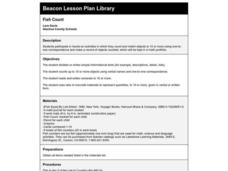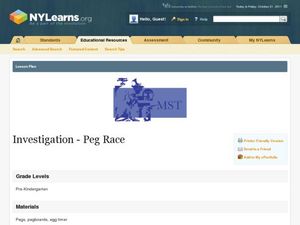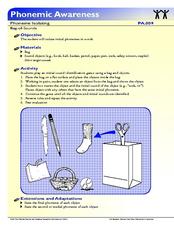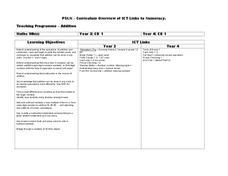Curated OER
Fish Count
Students participate in hands-on activities in which they count and match objects to 10 or more using one-to-one correspondence and make a record of objects counted, which be kept in a math portfolio.
Curated OER
Are You Here Today?
Students recognize their own name in print and the names of their classmates. They use one to one correspondence to determine who has not checked in, completed their field, and if absent indicate that on the form. Students tally the...
Curated OER
Number Lines and Whole Numbers
Use number lines to visually represent addition and subtraction equations. First, scholars complete an addition number sentence and represent the equation on a number line. Next, they examine a number line and write the corresponding...
Curated OER
Investigation - Peg Race
Students explore time by comparing the duration of an egg timer with how many pegs they can put in a pegboard. They experience one on one correspondence, as they place a peg in the whole. Students discover estimation of time and number...
Curated OER
Power Question #1
In this power question worksheet, pupils explore functions and their one-to-one correspondence. This one-page worksheet contains four multi-step problems which include proofs.
Florida Center for Reading Research
Phonological Awareness: Phoneme Isolating, Bag-of-Sounds
In pairs, pre-readers take turns holding up objects from a bag. As one child holds up an object, the other names it and says its initial letter sound. They work together to sort the objects into piles based on how they isolated and...
Illustrative Mathematics
Comparing Numbers
Young mathematicians spin their way to a deeper number sense with this fun, collaborative activity. Using two spinners, one with the numbers 0-9 and the other with the decades 00-90, pairs of learners take turns building and comparing...
Curated OER
What's the First Letter? (A to H)
Here are eight words, and each of them is missing a letter. Not just any letter but the first letter. Oh my! Put your phonics masters to work and have them determine which of the eight letters (a-h) completes each word.
K-5 Math Teaching Resources
Numeral Cards 0-10
Looking for number cards? Look no further than this numeral card printable showcasing numerals one through ten.
Curated OER
Curriculum Links To Numeracy
Youngsters practice looking for the links to numeracy in their classes. This isn't a worksheet but a curriculum guide for an entire unit. Teachers can use any part of the resource to extend or inform their teaching practices related to...
Florida Center for Reading Research
Phonics: Letter Recognition, Clip-A-Letter
Young scholars show what they know about the alphabet. With two circles—one surrounded by capital letters and one with lowercase—pupils use clothespins to match letters, case to case or the opposite.
Illustrative Mathematics
The Napping House
How many people and animals can cram into a single bed? Find out with this cross-curricular math and language arts lesson. Following along with a reading of the children's book The Napping House by Audrey Wood, young mathematicians...
One Billion
Math, Age 3-5
Jump start children's math education with this fun basic skills resource. Offering dozens of different touch-and-swipe activities with colorful graphics, this program is perfect for all young learners.
Illustrative Mathematics
Running to School, Variation 2
Rose's commute to school is a fractional distance. After she runs part of the way, your class needs to determine what fractional distance she ran. This problem explores fraction operations through modeling and computation. The...
Gilder Lehrman Institute of American History
Harriet Beecher Stowe Sends Uncle Tom’s Cabin to Victoria and Albert, 1852
Harriet Beecher Stowe's plea for abolition is not only laid plain in her acclaimed novel, Uncle Tom's Cabin, but in her written correspondence as well. High schoolers read a letter written by Stowe to Prince Albert and Queen Victoria to...
Curated OER
Counting: 1-100
A simple worksheet with pictures of drums in a 100-chart format. Have your students count the drums, and identify where the drums are that correspond to numbers ending in zero and five. Enlarge on a copier to 11x17 sized paper so...
Florida Center for Reading Research
Letter-Sound Dominoes
What do dominoes and phonemes have in common? Quite a bit in this engaging phonics game! Each domino has a letter on one side and an image on the other. Everything you need is here; partners place the starting domino on the table then...
Curated OER
The Ants Go Marching
Integrate art, math, life science, music, and fun in this beginning addition and subtraction activity. Children kinesthetically represent adding and subtracting numbers to 10; they stand up one at a time as you count forward and sit down...
Briscoe Center for American History
Mary Maverick and Texas History - Part 1
What's the difference between a diary and a memoir? Young historians explore the ramifications of this question as they learn how to use primary source materials to gain an understanding of life on the Texas frontier.
Illustrative Mathematics
Two Lines
Here is a resource that helps your algebra learners understand the connection between the graph of two lines, the equations of lines, and the solutions and intersecting points of lines. It would make a great assessment question, but can...
Florida Center for Reading Research
Phonics: Varient Correspondances, Silent "e" Changes
Engage early readers in a silent e activity to help them understand the changes the letter can make to a simple word. With the provided cards, learners read and write each word as it appears without the silent e. Then they read and write...
Aurora City School District
Do Not Try to Kid a Kidder: The Art of Persuasion
The power to convince others of your argument lies in your knowledge of rhetoric! A thorough packet covers the basics of persuasion, including logical appeals and fallacies, and applies strategies to letters to the editor,...
Florida Center for Reading Research
Phonics: Letter-Sound Correspondence, Photo Chart
Have fun with student photographs in this phonics activity! Learners sort their classmates' photos by initial sound on a large poster board with the alphabet written vertically down the left side. Also provided are various pictures...
Curated OER
Generating Number Sequences
Practicing number sequences, learners solve 5 various problems that include determining various number sequences in each. First, they work out what number comes out of each of the given machines. Then, students write down the first five...

























